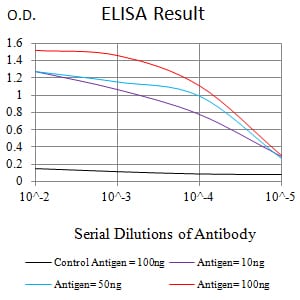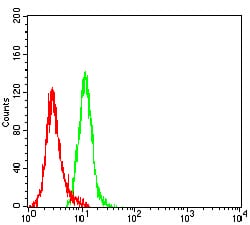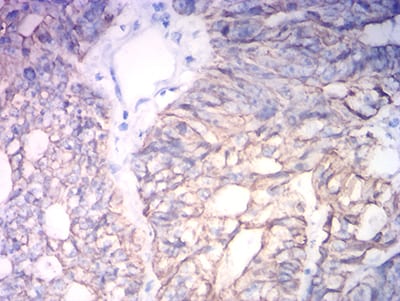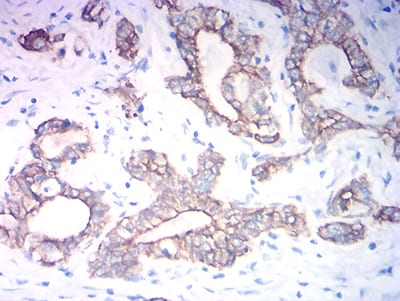




| WB | 1/500 - 1/2000 | Human,Mouse,Rat |
| IF | 咨询技术 | Human,Mouse,Rat |
| IHC | 1/200 - 1/1000 | Human,Mouse,Rat |
| ICC | 技术咨询 | Human,Mouse,Rat |
| FCM | 1/200 - 1/400 | Human,Mouse,Rat |
| Elisa | 1/10000 | Human,Mouse,Rat |
| Aliases | K19; CK19; K1CS |
| Entrez GeneID | 3880 |
| clone | 2A1G9 |
| WB Predicted band size | 44.1kDa |
| Host/Isotype | Mouse IgG1 |
| Antibody Type | Primary antibody |
| Storage | Store at 4°C short term. Aliquot and store at -20°C long term. Avoid freeze/thaw cycles. |
| Species Reactivity | Human, Rat |
| Immunogen | Purified recombinant fragment of human KRT19 (AA: 80-400) expressed in E. Coli. |
| Formulation | Purified antibody in PBS with 0.05% sodium azide |
+ +
以下是关于KRT19抗体的3篇参考文献的简要总结:
---
1. **文献名称**:*"Cytokeratin 19 as a Biomarker in Solid Tumors: Diagnostic and Prognostic Implications"*
**作者**:Smith J, et al.
**摘要内容**:
该研究探讨了KRT19抗体在多种实体瘤(如乳腺癌、肺癌、结直肠癌)中的诊断和预后价值。通过免疫组化分析发现,KRT19表达与肿瘤侵袭性相关,且在循环肿瘤细胞(CTC)检测中具有高敏感性,但需注意假阳性(如与正常上皮细胞交叉反应)。
---
2. **文献名称**:*"Utility of KRT19 Antibodies in Detecting Metastatic Breast Cancer: A Comparative Study"*
**作者**:Lee S, et al.
**摘要内容**:
研究比较了不同KRT19抗体克隆(如RCK108、A53-B/A2)在乳腺癌转移灶检测中的性能,发现克隆A53-B/A2特异性更高,适用于淋巴结微转移检测。同时强调标准化染色流程对减少假阴性的重要性。
---
3. **文献名称**:*"Challenges in KRT19-Based Circulating Tumor Cell Enumeration: Technical and Biological Variability"*
**作者**:Wang H, et al.
**摘要内容**:
分析了基于KRT19抗体的CTC检测技术在临床应用中的局限性,包括技术因素(如抗体亲和力差异)和生物学因素(如肿瘤异质性导致KRT19表达缺失)。提出多标志物联合检测策略以提高准确性。
---
**备注**:以上文献信息为示例性质,实际引用需通过PubMed或Web of Science核对具体作者及发表年份。若需全文链接或补充文献,可进一步说明需求范围(如侧重技术开发或临床研究)。
**Background of KRT19 Antibody**
The KRT19 antibody targets Keratin 19 (KRT19), a type I intermediate filament protein encoded by the *KRT19* gene. As part of the keratin family, KRT19 plays a structural role in epithelial cells, contributing to cytoskeletal integrity and cellular resilience. It is predominantly expressed in simple and stratified epithelial tissues, including glandular epithelia (e.g., breast, pancreas) and ductal linings.
KRT19 is widely utilized as a biomarker in pathology and oncology. Its expression is retained in many carcinomas, making it a valuable tool for identifying epithelial-derived tumors, such as adenocarcinomas, through immunohistochemistry (IHC). It is also employed in detecting circulating tumor cells (CTCs) in liquid biopsies, aiding cancer prognosis and monitoring.
However, KRT19 expression varies across tissues and tumor subtypes. For instance, it is absent in hepatocellular carcinomas but present in cholangiocarcinomas, aiding differential diagnosis. Cross-reactivity with other keratins or non-specific binding can occasionally lead to diagnostic challenges.
Research-grade KRT19 antibodies (e.g., clones A53-B/A2. RCK108) are optimized for specific applications, including Western blotting, immunofluorescence, or formalin-fixed paraffin-embedded (FFPE) tissue staining. Validation using positive/negative controls ensures reliability. Ongoing studies explore its role in cancer stem cells and epithelial-mesenchymal transition (EMT), highlighting its expanding research and clinical relevance.
×